This season, FC Copenhagen were very impressive in the UEFA Champions League, qualifying from a group containing Galatasaray, Manchester United, and Bayern — impressive considering the Danish champions had to play six games in the qualifiers to even get into the group stage, now facing Man City in the last 16.
There are many analyses out there covering Roony Bardghij, who was a very promising young winger.
But another player who was a standout in the whole process was Elias Jelert, who’s already earned 2512 minutes under Jacob Neestrup this season; the 2003-born Danish international primarily played as a right-back but also occasionally as a left-back.
This FC Copenhagen tactical analysis is a Elias Jelert scout report that profiles the player’s strengths and explains why he could be the next defender hunted by clubs in bigger leagues.
Elias Jelert Style Of Play – Ball carrying & progression
Under Neestrup, FCK have consistently been playing a 4-3-3 formation, and setting quite positionally tactics, players had their given roles in build-up and ball progression.
The ball-carrying actions from Jelert could be observed in the following graph.
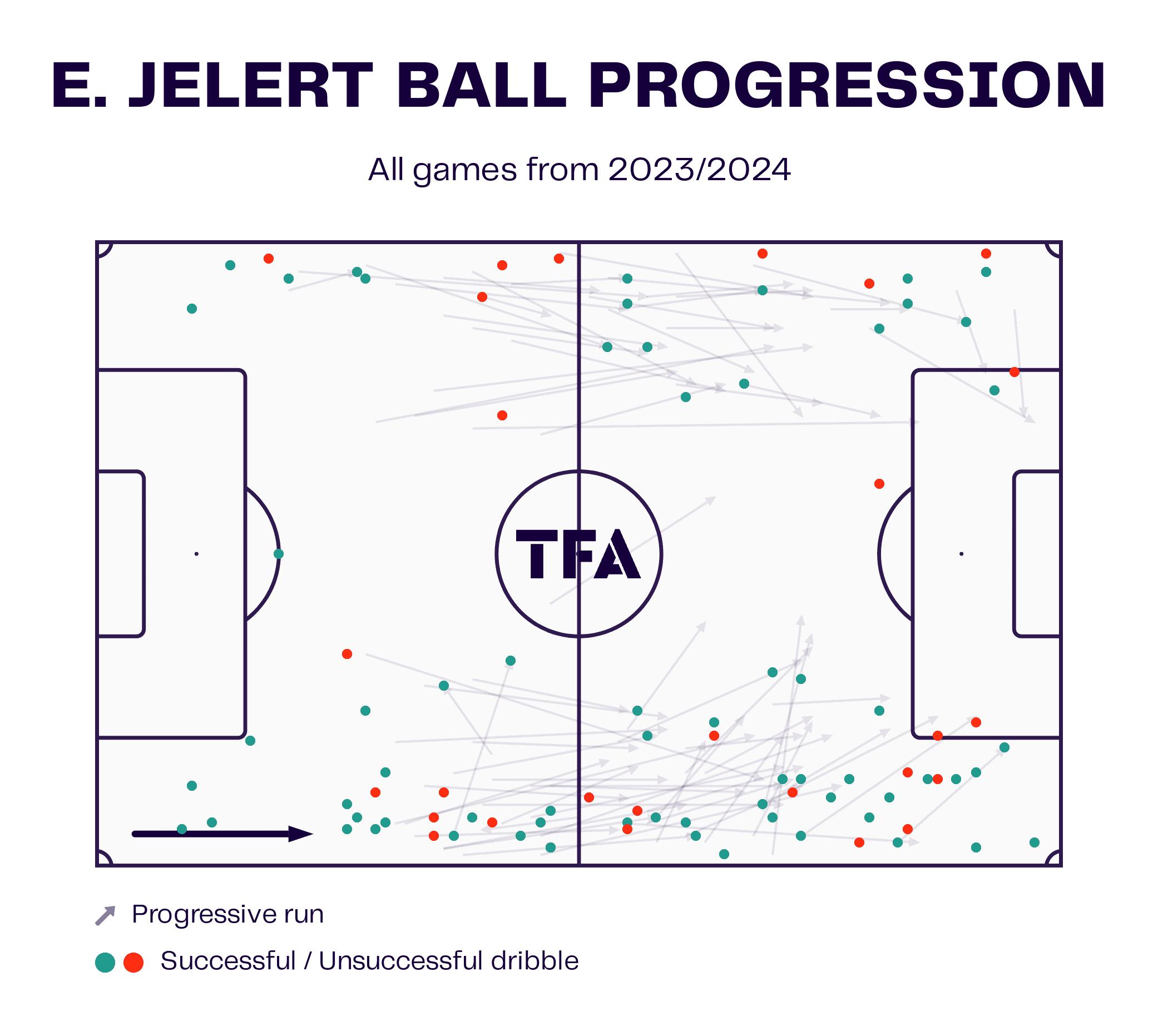
The dribble distribution was really interesting.
On the left flank, Jelert’s had a good success ratio in the attacking half, but it’s been average in his own half.
It was the opposite story when he was on the right flank.
Contrarily, he had more successful dribbles in his own half than he did in the final third.
It implied his behavioural pattern could rely more on passes in the opposition half despite having an excellent ability to take on in his own half.
Notice the direction of the ball carrying as well.
On the left side, he’s been bringing the ball forward vertically, which is unsurprising.
But on the right side, he’s made multiple carries to the centre of the pitch, an interesting trait given he’s a right-footed player.
Let’s look at the value of his take-ons and how they’re important to FCK’s game.
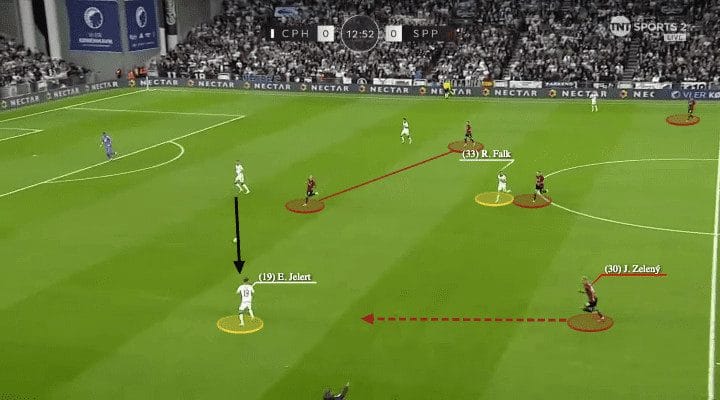
We picked this example from the UCL qualification clash between FCK and Sparta Praha.
The Czech Champions were aggressively pressing man-man; they played a 3-4-3 formation but kept the striker on FCK’s holding midfielder (33.
Rasmus Falk), so their opponent could not play into centre easily.
As a result, it was more like a “1-2” up top.
They matched the opposition’s wide defender with their wing-backs pressing high up.
It was a 4v4 excluding keeper and far-side defender, and Jelert was receiving under the pressure of Jaroslav Zelený.
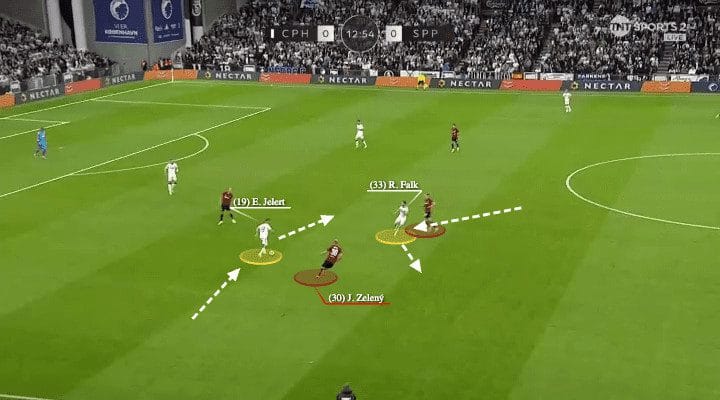
If the player is not composed with the ball, they might panic and kick it forward or hand responsibility to a teammate.
But in the second image, we see Jelert did fine when he had to solve this situation.
He read the space very well and brought the ball inside, as Falk moved deep and moved away in the process.
Then, Zelený almost had to give up his mark as his approaching angle could not hinder Jelert’s ball-carrying action.
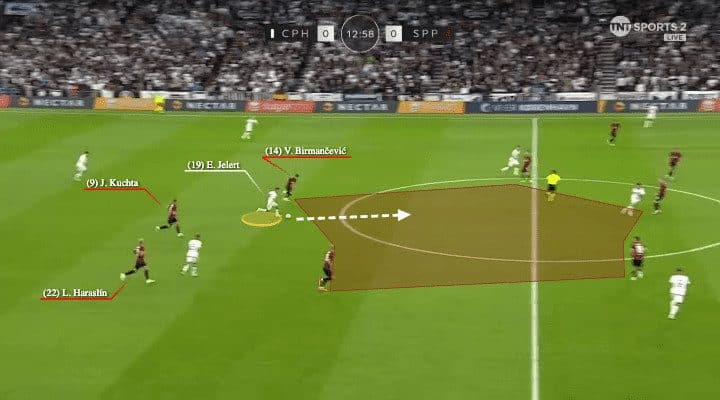
And even better, Jelert did not simply choose a pass after solving Zelený’s pressure.
Instead, he was brave enough to keep going and tried to drive forward into the centre as Sparta Praha had already shown them the space.
Jan Kutcha probably did not expect this as he was mainly focusing on Falk, while Veljko Birmančević had to track back to try to close Jelert.
This decision shows that he could chain his actions together and continuously search for optimal conditions on the pitch.
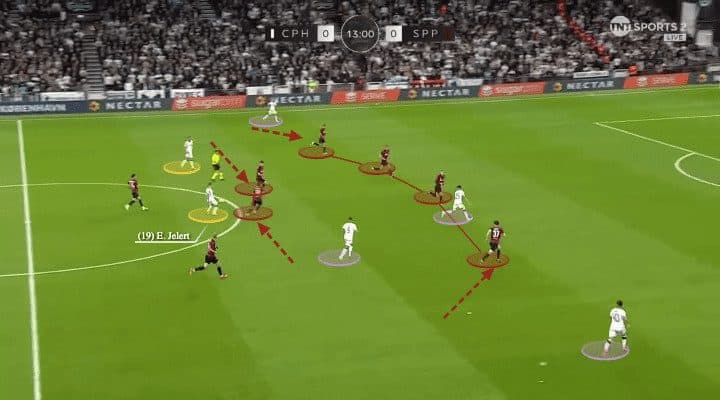
Now, the reward was shown from Jelert’s good action.
The two-man Sparta Praha midfield had to close the gap in the centre, while the backline (without Zelený) also had to fall back. In the front, it was pretty advantageous to FCK when they had a 4v4 with their attackers running towards the defence, while Jelert himself also got two near passing options around.
The scenario was full of dynamics, and FCK ended the attack with a shot.
As this example has shown, Jelert’s ball carrying could help teams solving man-man press and open new situations, turning potential risks into their own advantages to attack the opponent.
Final third output
In recent years, the likes of Trent Alexander-Arnold and João Cancelo have become the benchmark of modern full-backs, as they could execute multiple tasks in different phases of plays while still being very influential in the final third.
Compared with these two players, Jelert is not as powerful when he arrives in the last third, but he is still performing to a decent level this season.
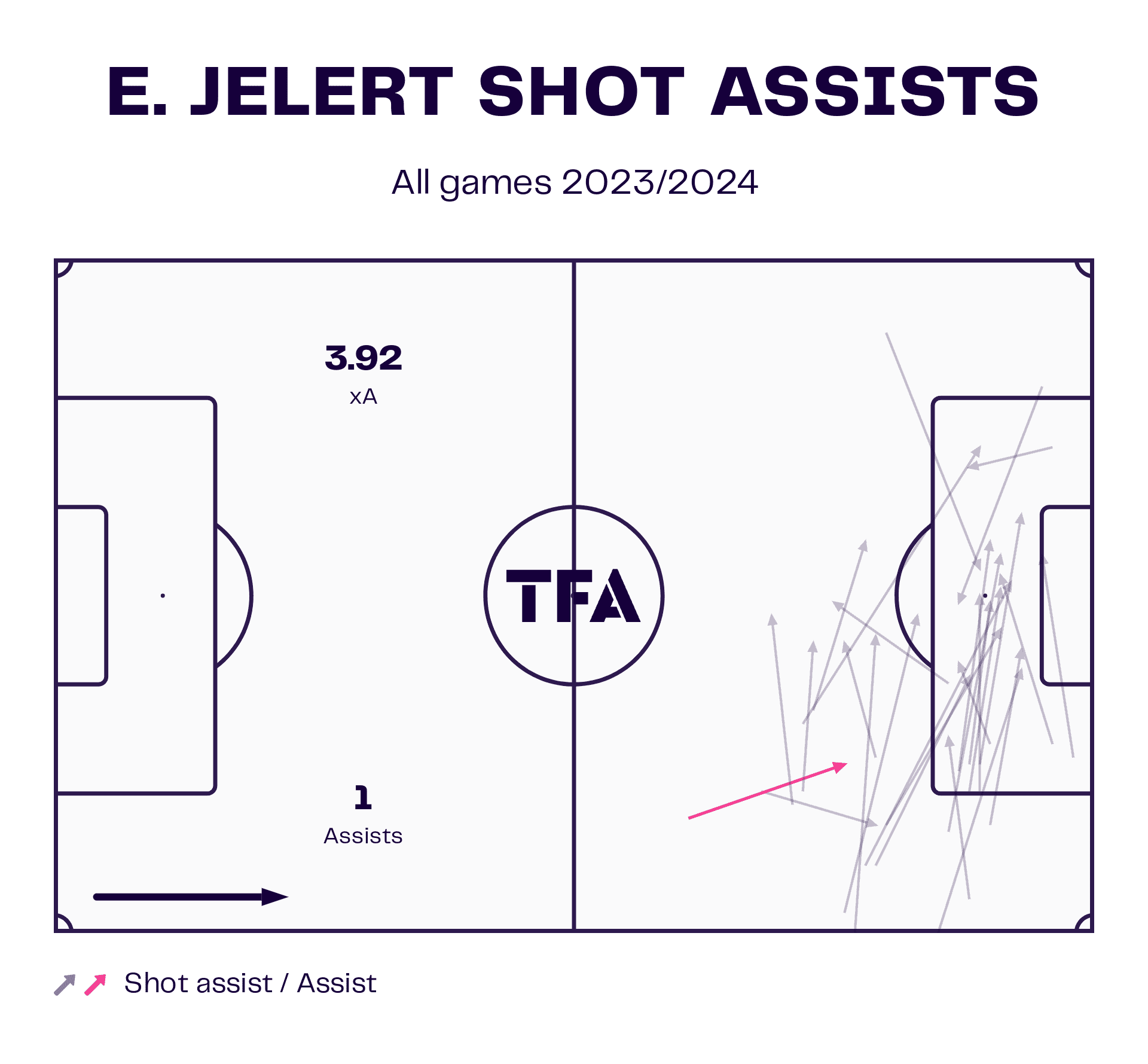
Despite only registering one assist in the season, Jelert’s xA sits way higher at 3.92, but his teammates haven’t been converting his crosses.
But it shows that he could also create threats from both the right flank and left flanks.
Most crosses have been going to the penalty spot according to the viz, but there were also cutbacks and flat passes into the centre; these are the main methods of Jelert’s actions in the offensive third.
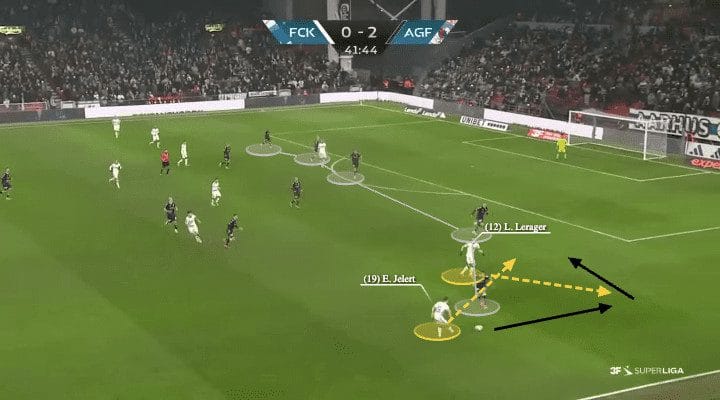
Here, we chose an example of Jelert’s offensive third action; some Scandinavian full-backs were usually very used to making overlaps, but Jelert could also make underlaps – which was based on the context.
Against AGF, he made a good pass and move action after giving the ball to Lukas Lergaer, who was running to the outside.
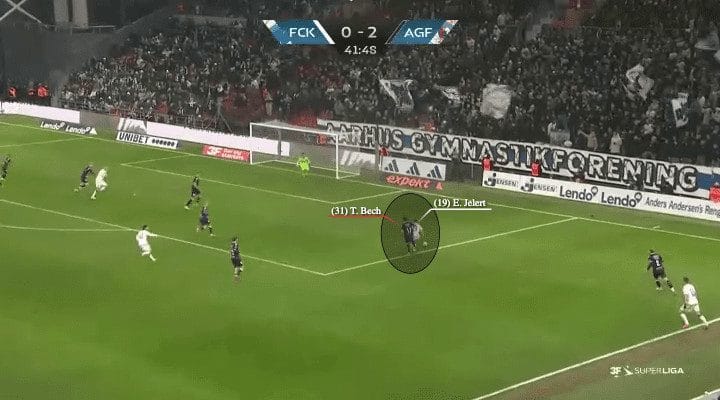
Then, Lerager returned with a pass into the space instead of Jelert’s feet, so the 20-year-old full-back had to go into contest with his tracker (Tobias Bech).
In the second image, the focus was not only about the run but also on his ability to read the space and use his body to protect the ball; then, Bech was separated behind and could hardly try to take the ball from Jelert.
From there, Jelert had the space to put in a cross.
Elias Jelert Defensive composure
Compared with his decent on-the-ball abilities, Jelert was even more impressive when he defended.
He produced some really good performances in the UCL qualifiers and also in some tough away games.
When FCK weathered the storm against Raków Częstochowa, he was one member of the Danish side who played an excellent game to help his team win 1-0 away from home.
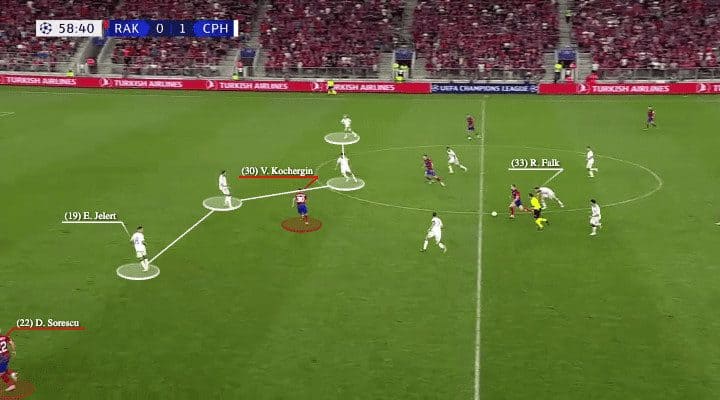
In this post-long play sequence, Raków Częstochowa eventually retrieved the second ball, and the FCK holding midfielder (33.
Falk) was left behind Gustav Berggren.
Then, FCK’s last line was incomplete because of the previous contest, but the Polish champions already had Deian Sorescu and Vladyslav Kocherhin running forward.
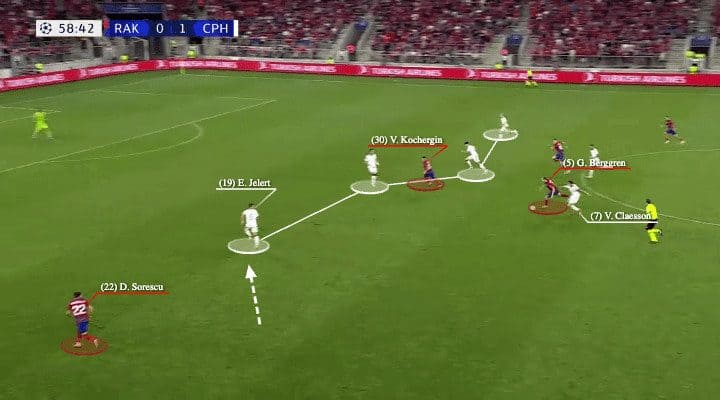
After Berggren got himself in front of Falk, Viktor Claesson of FCK also got impatient and rushed into a challenge, which was late, and Berggren escaped again.
Now you can also see the FCK’s last line was retreating while Jelert was moving into the centre to reduce his distance with his right centre-back.
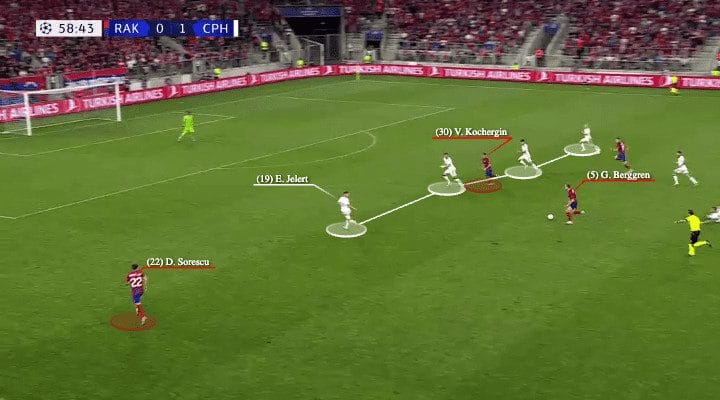
After Claesson also got cancelled in the sequence, Berggren was driving towards the defence.
It was a 4v4 situation.
Worse still, Jelert were more in a 1v2 situation as he had Sorescu to handle on the left side, while Berggren’s dribbling direction was more towards him.
However, Jelert was very patient enough and did not commit to the ball holder.
He kept himself in line with his teammates and kept retreating.
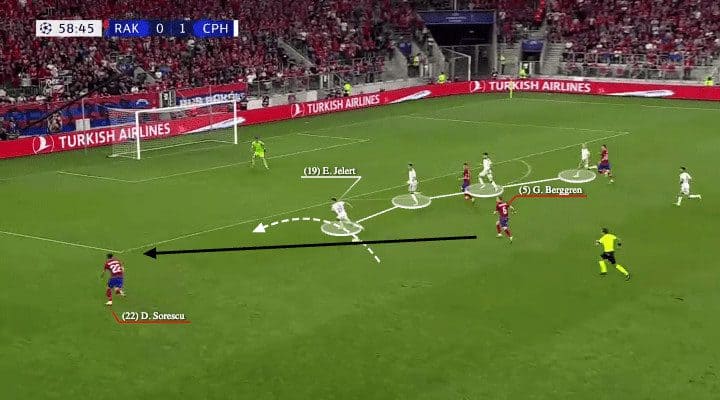
Only when Bergreen was impatient and made the pass did Jelert turn himself around quickly and follow up, dashing towards the receiver and putting pressure on him.
If Jelert rushed into a challenge on Berggren and was taken out, the outcome would be the opposite: FCK’s last line would be broken, and his teammates would have to react.
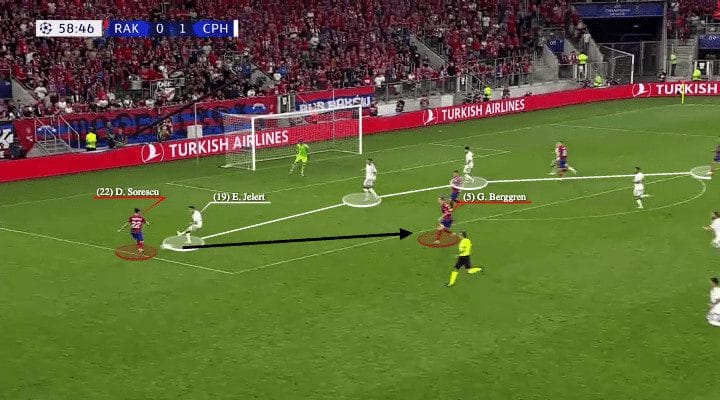
Now, the situation was more predictable as Raków Częstochowa were invited to the flank, and Jelert was putting instant pressure on Sorescu, who didn’t try to dribble but passed the ball back to Berggren, who was in front of the last line.
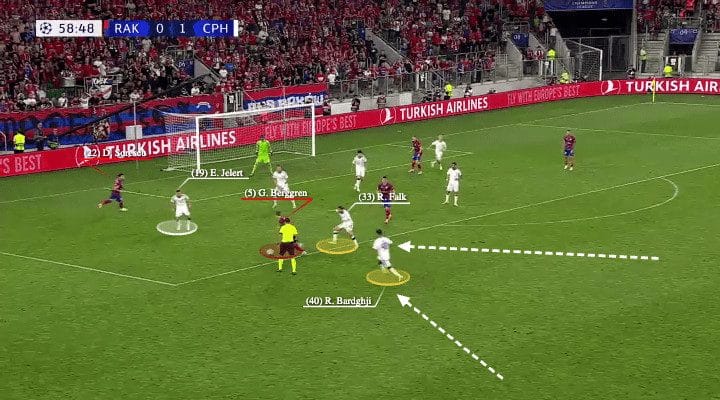
And in the whole process of Raków Częstochowa moving the ball, Jelert delayed the threat as long as possible and bought time for his teammate to run back into his defensive area.
Then, the opponent missed the best timing to exploit the exposed defence.
When Berggren received it again, both Falk and Bardghji were helping from behind, so he had to go to the side, but this time, Sorescu was not a passing option as he was offside now.
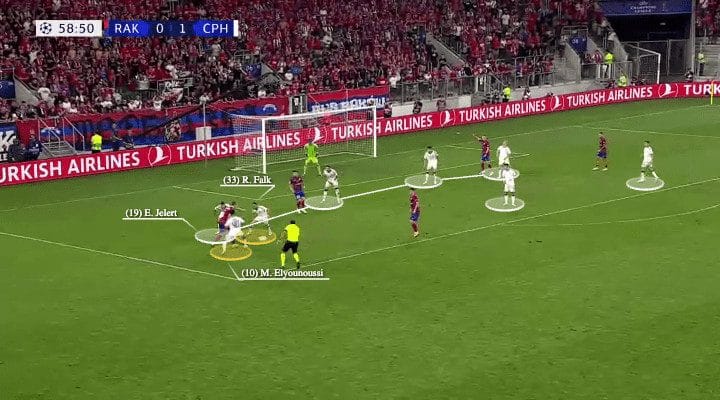
Berggren ended up running himself into a narrower playing angle, with three opponents surrounding him.
At the same time, FCK already retreated eight players to defend the penalty box, which was enough to handle the attack if the cross came in.
So, Jelert removed the counterattack threats from Raków Częstochowa without really making an interception or sliding tackle.
This was all about defending the space and managing the situation.
He did it incredibly well, and also, in other games, the calmness was not easy to find from a 20-year-old defender.
Conclusion
As we outlined in this Elias Jelert tactical analysis, Jelert is not a full-back like Trent Alexander-Arnold, who could play incredible crosses into the penalty box.
But his qualities have been essential to his team and helped them be solid in different parts of the game, especially on the defending side.
According to Transfermarkt, Jelert’s market value is only €5m; at anything around this valuation, he would be a terrific bargain for any club that tries to get him onboard.





Comments